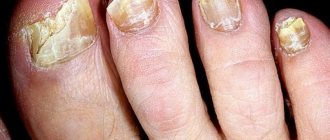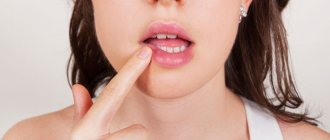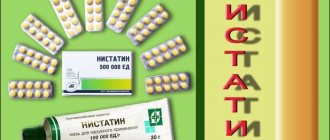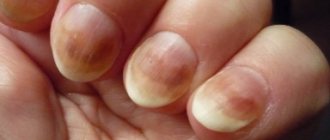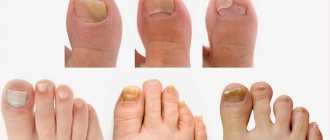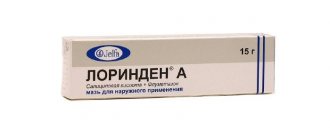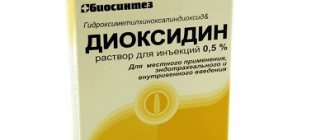You can try to cope with toenail fungus using folk remedies. However, such treatment can only be effective when the first symptoms appear (see pictures), i.e. in the initial stages of damage to the nail plate, and even then, not always.
Remember, if someone tells you that you can get rid of nail fungus quickly, it is not true ! Removing fungus is a long and tedious process.
We strongly recommend that you consult a doctor or use pharmaceutical medications.
So, what folk remedies can cure nail fungus:
Iodine
An alcohol solution of iodine is the most popular treatment for toenail fungus at home. Let's explain why. This strong antiseptic has proven fungicidal properties.
In addition, iodine is able to force proteins to coagulate and destroy them.
This property helps iodine fight fungal diseases, because It is reliably known that the fungus has a protein structure.
Available to the general public due to its low cost, iodine is used not only to restore nails, but also for damaged areas of the feet and interdigital areas. But before you start treating nail fungus with a medicine such as iodine, remember that:
- Iodine kills most types of fungi, but not all.
- Iodine can provoke allergies, so a day before the start of the intended course of treatment, place a drop of iodine on the bend of your elbow. A contraindication to treatment will be the occurrence of itching or redness. In this case, try another traditional method of treating fungus.
- Iodine treatments cause the nail to turn yellow.
- Burns, dermatitis, and even problems with the thyroid gland are possible.
- The drug is suitable only for nails affected by a fungal infection in the initial stage, when less than 1/3 of the nail is affected by the fungus.
Now you know how to treat nail fungus with iodine, and it’s time to choose the appropriate recipe.
Option #1. A 5% alcohol solution should be applied twice a day, one drop to the nail affected by the fungus. This can be done conveniently with a cotton swab. Iodine can also be applied to healthy nails, but in a smaller dosage: one drop every two days.
Option #2. Add iodine to a bowl of hot water and steam your feet in it for 10 minutes. Then the infected pieces of nails are cut off, and 3% hydrogen peroxide is applied to the skin. The procedure is completed by applying a bandage with antibacterial ointment.
Option #3. Course – 6 weeks. For the first two weeks, nails are treated with fucorcin twice a day, the next two with iodine solution, and the last two with 9% vinegar.
Option number 4. Pour 1 tsp into a separate container (a medical bottle will do). iodine, nitrofungin, vinegar essence, garlic juice. You need to lubricate the damaged nail with the resulting mixture, after steaming it and cutting off the loose part. The medicine is applied at night and must be shaken before application.
Option #5. Course – 1 month. Every evening you need to do a 30-minute salt bath (for 1 liter of hot water, 2 tablespoons of sea salt and 1 tablespoon of soda). After half an hour, without removing your feet from the water, the affected areas of the skin and nails are polished with a nail file or cut off with scissors. Then your feet should be washed with soap, put on gloves and treat the entire surface of the foot, nail beds, and areas between the toes with iodine. On nails that are affected by fungus, iodine is applied three times, waiting for each layer to dry.
Treatment with iodine usually lasts about 2 months.
Whatever recipe you adopt, remember: you cannot treat healthy and fungal nails with the same tools! Otherwise, the fungi will migrate to the healthy nail plate.
As always, we remind you that traditional medicine can only be a complement to traditional medicine. Be sure to consult your doctor!
How can you get a fungal infection?
Fungal infection can occur not only in a public place, but also in a home environment. Among public places, special care should be taken where there is high humidity. In a humid environment, fungal spores live much longer, multiply quickly and easily infect a person who accidentally comes into contact with them with an exposed part of the body. Ideal places for infection are:
- baths;
- saunas;
- swimming pools;
- showers;
- SPA;
- toilets.
In a home environment, the fungus is most often transmitted through slippers, towels or carpets, especially if an infected person has been or lives in the house.
Important! If there is an infected person in the house, you need to minimize all contact with the things he uses.
The following factors can also provoke the development of fungus:
- poor quality, tight shoes;
- nail plate injuries;
- failure to comply with personal hygiene rules;
- nail extensions.
Tea mushroom
Kombucha, immersed in a sugar solution for 7-8 days, produces a healing sweet and sour drink. It has many medicinal properties, including the ability to kill pathogenic bacteria and inhibit their growth.
This is why traditional healers use kombucha to treat fungal nail infections.
You can use kombucha in two traditional ways: rubbing and applying a compress.
Rubbing. Free a small piece of kombucha from the films and grind to a paste. It should be rubbed into the nail plates affected by the fungus 2-3 times a day.
Compresses. Separate one layer from the kombucha and soak it in water. This completes the preparations for applying the compress. In the evening, a piece of mushroom should be placed on the nail plate, cellophane should be placed on top of it and 2-3 socks should be put on so as not to stain the bed linen. The pain that occurs during the first few procedures is worth enduring for the sake of recovery.
In the morning, remove the compress, wash your feet in warm water, and then begin to remove dead nail pieces. The damaged surface is lubricated with a strong solution of potassium permanganate or brilliant green. Treatment of nail fungus with kombucha continues for 3-7 days, and another 1-2 days for preventive purposes.
And yes, according to official medicine, the effectiveness of this remedy is questionable.
Prevention
The risk of fungal infection can be significantly reduced by following simple prevention tips:
- keep shoes clean;
- buy only high-quality shoes;
- do not use other people's shoes and clothes;
- change socks regularly;
- do not take off your shoes in public places or have a clean spare pair (especially in a bathhouse or swimming pool);
- always keep your feet and hands dry;
- fight excessive sweating;
- keep the bathroom clean;
- observe the rules of personal hygiene;
- Always use a personal manicure set.
The prevention of nail fungus is described in the video:
Traditional methods of treating fungus give the most noticeable results in the initial stages. If the nail has significantly changed color, began to peel off or move away from the nail bed, it is recommended to visit a doctor who, in addition to the methods already used, will recommend the most suitable medications for the specific situation.
Copper sulfate
Fans of traditional healing methods use copper sulfate both to treat infectious diseases and to treat toenail fungus. Often, treatment of nail fungus with copper sulfate is combined with taking medications.
There are two options for using copper sulfate:
1. Copper sulfate solution. It is prepared like this: in 1 liter. boiled water dissolve 1 tsp. vitriol. This is a concentrated solution, so it must be diluted before use - 1 tablespoon of solution in 1.5 liters of water.
- The water for the bath is heated (it should be warm)
- Add the required amount of solution.
- Place your feet in the bath for 10-15 minutes.
- Treat the nail plates with a product prescribed by the doctor.
2. Ointment. Heat copper sulfate (1 tsp) in a frying pan until it changes color - it should turn white or gray. Then add 1 tsp taken as well. yellow sulfur powder, tar (or goose fat). Mix all components and heat. Apply the resulting ointment to sore nails.
How to treat toenail fungus
Nail fungus: signs and causes
Nail fungus (onychomycosis) is an infectious disease. The causative agents of the pathology are most often dermatophyte fungi. Infection is possible while visiting public places:
- baths;
- swimming pool;
- gym;
- manicure salon.
Sand on the beach can also be dangerous in this regard, because the pathogen can live in it for a long time.
Nail fungus is an infectious disease that is easily transmitted and quickly spreads to adjacent areas of the fingers.
According to statistics, 25% of the world's population has fungal nail disease, while most victims are not even aware of the problem.
Risk factors for developing the disease:
- excessive sweating of the extremities;
- elderly age;
- male gender;
- activities associated with exposure to high humidity;
- wearing tight shoes;
- the presence of a person infected with a fungus in the family;
- damage, cracks in the skin or nails;
- diabetes, reduced immunity.
Most often, the toenails are affected, which is associated with increased sweating of the feet compared to the hands.
You can suspect the presence of pathology based on the following signs:
- nails begin to peel, crumble and break;
- the nail plate thickens or becomes too thin, spots appear underneath it;
- The color of the nail plate changes: it can become yellow, white or even black.
I personally have not had to deal with nail fungus, but my mother developed a problem. Her always beautiful and well-groomed toenails suddenly became very unattractive to look at. The nail plate darkened, began to thicken and crumble. At first, my mother tried to hide the defect under a layer of varnish, but this did not solve the problem, so she had to seek medical help. Since the disease was already quite advanced, it was necessary to undergo complex and long-term treatment, using both pharmaceutical and folk remedies.
Video: forms of nail fungus
Birch tar and tar soap
Birch tar is a product obtained by dry distillation of birch bark. It is successfully used as an antiseptic and anti-inflammatory agent. Treatment of nail fungus with birch tar is also effective, because it perfectly softens dead skin. Traditional healers suggest lubricating the skin with pure birch tar, as well as applying shaken mixtures and ointments prepared on the basis of tar.
Natural birch tar is applied to previously treated feet: they are steamed in a soap bath (15 minutes), after which the nails affected by the fungus are trimmed and dead skin is removed from the feet. The interdigital areas are wiped dry, and birch tar is applied to the affected areas with a cotton swab, lightly rubbing into the skin.
For 1.5 hours you should not move or put on anything. The ointment should be absorbed into the skin with air access. Then socks made from natural materials are put on your feet. After 2-3 days, wash your feet in cold water and soap and repeat the procedure again. During treatment, you can treat insoles with birch tar.
Treatment of nail fungus with tar is also possible with ointment. To prepare it, you should take any fat base (baby cream, for example, or interior fat), and add tar to it. At the beginning of treatment, its concentration should not exceed 5%. Subsequently, up to 15-20% of tar can be used.
Some people prefer to use sulfur-tar ointment. It contains 3 parts tar, 2 parts sulfur powder and 10 parts fat base. These components are heated and mixed until smooth. This ointment is applied to the nail, and a patch is placed on top.
It is most convenient to use a talker. It consists of glycerin and tar, taken in 50 ml and 70 ml. alcohol Mix the ingredients in a dark bowl and lubricate the affected nails several times a day.
About 10% of birch tar is contained in tar soap. Yes, it smells unpleasant, but the skin is well disinfected and quickly restored. Here are just a few options for using tar soap.
Option 1. Foot baths. Grate tar soap, measure out 2 tbsp. Bring this amount until completely dissolved in 2 liters of hot water, and then immerse your feet in the solution for 15-20 minutes.
Option 2. 1 tbsp. grated soap, slightly diluted with water, add 2 tsp. baking soda and stir vigorously. The resulting mixture is rubbed into the affected nail. Do this once a day using a hard toothbrush.
Option 3. Nails are thoroughly soaped with tar soap, and table salt is sprinkled on top of the foam. Fingers and feet are wrapped in bandages for aesthetic reasons. In the morning, the bandage is removed and the feet are washed with warm water. It is believed that after a week the fungus should recede.
Surgical methods of treatment
Surgical intervention is resorted to in the most extreme cases, when all other means have not improved the condition of the nail.
Therefore, in a hopeless situation, the patient will need to choose one of the following methods that are practiced in modern surgery:
- Hardware pedicure - the doctor removes the upper affected layer using special attachments. The procedure is quick and painless, but there is a risk of an allergic reaction.
- Laser nail removal is one of the most effective treatment methods (the laser destroys fungi without damaging healthy tissue). The duration of the procedure is several minutes.
- Chemical method - nail removal is carried out using keratolytic drugs (Nogtimycin, Nogtivit). In general, the procedure is as follows: the nails are steamed in a soap-soda solution and the medicine is applied, after which they are sealed with a band-aid. After 4 days, the nail plate is removed with nail scissors. The procedure is painless, but requires several sessions.
- Surgical method - complete removal of the nail plate. The procedure is painful and is performed under local anesthesia. The operation is indicated at the last stage, when the nail has almost crumbled.
Sea and table salt
Table salt disinfects pathogenic microflora, and sea salt helps soften the nail and acts like an antiseptic.
We are not talking about treatment here, but only about auxiliary therapy.
- Salt and soda need to be dissolved in cold water. The ingredients are taken one spoon at a time. Session – 10 minutes, after which the feet are washed with warm water.
- Salt and vinegar baths are done every day. The solution is made from 100 g. salt (sea or table), 4 liters of water and 4 tbsp. vinegar.
- An effective method is to apply salt mixed with crushed mint to the affected nail plates.
- A cotton swab dipped in a solution of concentrated sea salt (a spoonful of salt per glass of water) is applied to the nail for a couple of minutes. At the end of the procedure, the feet are washed with soda water. The course of treatment is 10 days, while burning and itching are considered normal.
- Baths with sea salt and essential oils are also done for 10 days. For them, you will need to fill a basin with hot water at the rate of 1 liter. water 1.5 tbsp. salt, stir until the salt crystals are completely dissolved and add per 1 liter. water or 1 tsp. essential oil, or 1 tsp. lemon, or 0.25 ml. Yoda. The course is once a day for 10 days in a row, then a break of 2-3 days.
- Severe nail fungus is treated with garlic water. To prepare it, dissolve a spoonful of salt and a crushed clove of garlic in a glass of water. After complete cooling, the solution is filtered and another 4 tbsp is added. salt. The affected areas are treated with garlic water twice a day.
- A packet of salt is poured into a bowl, the foot is dipped in water and rubbed with salt. Then the wet salt is collected with dry salt, and the remains are brushed off with a brush.
Introduction
Toenail fungus (onychomycosis) is an infectious disease caused by mycotic microorganisms.
Molds and yeast-like fungi of the genus Candida, dermatomycetes, etc., of which today there are about 50 varieties.
In the absence of timely treatment, the disease progresses and is accompanied by symptoms such as deformation and discoloration of the nail plate (up to complete loss of the nail), pain and itching.
Therefore, it is extremely important to start therapy at an early stage , using all available means and methods. Otherwise, in a severe stage, the patient may require surgical assistance.
Vinegar: apple, wine and vinegar essence
Use vinegar at a concentration of 9%, no more
The fungus dies in an acidic environment. This is why vinegar is extremely popular among those who want to get rid of fungal nail infections. Treatment of nail fungus with acetic acid can help even in particularly advanced cases. But you need to prepare for a long course of treatment and possible burns.
The easiest way to use vinegar is to wet your nails with it, put on thick socks made of natural material and go to bed. You can mix iodine and 9% vinegar in equal proportions, and lubricate the nail plates and feet with the resulting solution.
Like any strong acid, vinegar kills fungus. And just like any acid, it can cause burns. Before you begin such treatment, ask yourself why you can’t buy a pharmaceutical product instead of vinegar?
Foot bath
Ingredients: bowl of water, 250 ml. vinegar (table or apple). Treatment principle and duration: heat the water, pour in vinegar, lower your feet and steam for 10-15 minutes before going to bed. The feet are wiped without rinsing, and antifungal agents prescribed by the doctor are applied. These baths are done every 2 days.
Lotions with vinegar
Ingredients: vinegar 9%. Treatment principle and duration: soak a cotton swab in vinegar, squeeze it out and apply to the nail affected by the fungus. The tampon should not protrude beyond the nail. Secure the cotton swab with an adhesive plaster and put on a sock. The course of treatment is 7 days, session once a day, then a break for 2-3 days.
Ingredients: 2 tbsp. essences, 3 chicken proteins (alternative - 1 tbsp glycerin), 2 tbsp. vodka. Treatment principle and duration: gauze or a cotton swab is moistened with the solution, which is then applied to the affected nail plate for 15 minutes. The course of treatment is 6-12 months, the procedure is every day.
Ingredients: vegetable oil, apple cider vinegar in equal proportions. Treatment principle and duration: a gauze swab is moistened with the solution, which is secured with a band-aid for convenience. Apply until a new nail grows.
Ointment
Ingredients: 2 tbsp. spoons 70% vinegar, 1 tbsp. dimethyl phtholate, 1 tbsp. glycerin, 1 tbsp. olive oil. Treatment principle and duration: after thoroughly mixing the components, the ointment is ready for use. It should be applied once a day to the nail plate with massage movements (you can use a cotton swab). Next, a plastic bag and socks are put on the feet. In the morning, wash your feet with laundry soap and warm water.
Traditional therapy for pathology: pros and cons
Pharmacies offer many drugs that can get rid of fungus. However, such funds are not available to everyone. For example, some medications cannot be used if you are pregnant or have an individual intolerance to certain components. In this case, patients turn to traditional medicine, especially since such treatment is cheaper, but no less effective and has a minimum of side effects. Healing baths, ointments, and compresses based on natural ingredients help improve the condition.
But it should be taken into account that it will not be possible to solve the problem quickly using folk remedies. A positive effect can only be achieved with regular and long-term procedures. In addition, therapy must be selected individually, since the disease has different forms.
During Soviet times, nails affected by the disease were treated radically - the nail plate was completely removed.
Traditional healers' recipes for treating nail fungus
Many recipes from the arsenal of traditional medicine were also used by our grandmothers and great-grandmothers. Such time-tested remedies should be used when the first symptoms of the disease appear, then the fight against it will be most effective.
Vinegar
The fungus dies in the acidic environment that is created when using vinegar as a medicine. This therapy has virtually no contraindications. In exceptional cases, the patient may have an individual intolerance to the product. During the procedures, a slight burning sensation may be felt, which is a normal reaction.
Vinegar for nail fungus is a traditional medicine that is inexpensive and effective.
Baths and lotions with vinegar
At the initial stages of the development of the disease, such a remedy, when used regularly, can relieve the problem without the additional use of medications. In addition, a vinegar bath is an effective prevention of fungal infections.
Stages of the procedure:
- Fill a basin with warm water. Its level should not be high.
- Pour 250 ml of 9% table vinegar into the water.
- Immerse the limbs in the solution for a quarter of an hour.
- Dry with a towel.
Repeat the manipulations three times a week until the condition improves.
After the bath, you can make a lotion using the same product. You need to soak a cotton pad in vinegar and apply it to the affected area for a quarter of an hour.
Vinegar ointment
This product is easy to use and can be stored for a long time.
For preparation you will need:
- acetic acid 70%;
- dimethyl phtholate;
- glycerol;
- olive oil.
The components are mixed in proportions of 2:1:1:1. The finished product is applied to the nails using a cotton swab and left for 8 hours, then washed off using laundry soap.
Use of vegetables and fruits
If the disease has just begun to develop, you can use garlic as a treatment, which has antifungal and antibacterial properties. At later stages, such treatment will have to be supplemented with medications.
Garlic is effective in the early stages of the disease
During treatment with garlic, care must be taken not to exceed the recommended dosage. Improper use of the product can lead to burns on the skin.
Effective recipes:
- ointment. To prepare the product, you need to chop peeled garlic (several cloves) with a garlic press. Mix the resulting slurry with vegetable oil in equal proportions. Apply the resulting product to areas affected by the fungus;
- tincture. This remedy will help destroy the infection. To prepare it, you need to squeeze the juice out of the garlic and mix it with alcohol and water in equal proportions. Leave for several days. The tincture is used to rub the nails several times a day until the condition improves.
Onion-based products can get rid of the problem. You can simply lubricate the affected areas with the juice of the plant once a day, or you can prepare an ointment from the husk. For this:
- Grind the dry husk to a powder.
- Add butter or lard (2:3).
The affected areas should be treated with the product before bedtime until the condition improves. Before the procedure, you should steam your feet and wipe them dry.
Fungal diseases are well treated by onion peels.
An effective remedy in the fight against onychomycosis is lemon. It will not only eliminate unpleasant symptoms, but also saturate the skin with vitamins. You can prepare a simple compress by cutting citrus into slices. Half of such a circle is applied to the nail overnight, wrapped in cling film and fixed with adhesive tape. The course of treatment is ten days.
You can simply lubricate the nail plates and the skin around them with citrus juice. After the product has dried, put on socks/gloves made from natural materials. Repeat morning and evening.
Lemon juice can cause irritation. To prevent this, you need to dilute it with water, and at the end of the procedure use baby cream to lubricate the nails and skin.
Treatment of nail fungus with lemon can be either an independent therapy or an auxiliary one.
Citrus juice is also mixed with turmeric, which has antiseptic properties. The resulting product, which should have the consistency of a paste, is applied to the nails three times a day until the condition improves.
An unusual way to treat a disease is to cut a small lemon in half, squeeze the juice from one half and put it on the diseased nail, attaching it with a band-aid. Wear 2 pairs of socks on top. This should be done at night every other day. The duration of therapy is 7 days.
Treatment with essential oils
Tea tree oil has an antiseptic and anti-inflammatory effect. This is an effective remedy against onychomycosis, as it directly affects the pathogen.
The product can be used:
- in its purest form. After steaming the nails, rub a few drops of oil into them without rinsing off;
- in the form of baths. Dissolve 15 drops of oil in water (50°), and immerse the limbs affected by the fungus for twenty minutes. Therapy lasts at least two months. The procedures are carried out every day, after which the areas affected by the disease are removed using manicure instruments.
Tea tree oil for nail fungus is a natural antiseptic that nature itself gives us
Other essential oils that have antifungal and antiseptic properties can be used for therapeutic purposes:
- lavender;
- carnations;
- cinnamon.
Oils (except lavender) are applied to the affected areas, be sure to first mix with any base oil (olive, almond). Manipulations are repeated 2-3 times a day. You can dip a cotton pad in the medicinal composition, apply it to the nail plate, secure it with a band-aid, and leave it overnight.
If the feet are also affected, then it is useful to treat them at night with a composition prepared from a few drops of essential oil with 1 tsp. basic tool. But your feet wear socks so as not to stain the bed. Or you can prepare a healing bath. To do this, dissolve 10 drops of ether in three liters of water. The duration of the procedure is 10–15 minutes.
Before starting treatment with any essential oil, it is worth conducting a sensitivity test. To do this, a small amount of the drug is applied to the wrist area. Wait 12 hours. If during this period no negative reactions such as redness, rash, etc. have occurred, then the product is approved for use.
Hydrogen peroxide therapy
Peroxide does not have pronounced antibacterial or antifungal properties. But it is a strong oxidizing agent that negatively affects the mycelium of fungi, which interferes with the growth and development of the pathogen. Hydrogen peroxide therapy is effective in the early stages of pathology and when used correctly.
The product is used externally in the form of lotions. The procedure is also called cryolin nail wrap. To carry it out:
- Feet or hands are steamed in warm water with the addition of soda (1 tsp per 1 liter of water).
- A piece of cotton pad is immersed in hydrogen peroxide and applied to the nail, wrapped in cling film.
- Leave for 15 minutes if fingernails are affected. If the fungus affects the toenails, the exposure time is increased to 40 minutes.
- Wash your hands or feet with plenty of water.
- Repeat 4 times a week.
To increase the effectiveness of the procedure, you can instill hydrogen peroxide into the nail cavity 3 times a day.
Treatment of nail fungus with hydrogen peroxide is one of the cheapest and most effective methods.
You can make medicinal baths that will relieve the disease. For this:
- 2 tbsp. l. hydrogen peroxide (3%) is diluted in 1 liter of water (about 50 °).
- The affected limb is immersed in the liquid for 15 minutes.
- Therapy is continued for 2 weeks. The procedures are carried out 2 times a day.
Video: an inexpensive and effective way to treat fungus
Propolis
Preparations containing propolis:
- relieve itching;
- prevent the development of bacterial infection in cracks and wounds;
- prevent infection from affecting healthy tissue.
For therapy to have a positive effect, the remedy must be used systematically. You need to purchase propolis tincture at the pharmacy kiosk. Moisten a cotton pad in it, fix it on the affected nail with a patch until it dries, then replace it with a new one.
Propolis-based products for nail fungus have been used since ancient times
After some time, the affected layer of the nail plate will begin to peel off. This is a sign that recovery is near. After a few months of regular procedures, the problem will disappear.
The following remedy with propolis tincture is effective even in advanced stages of pathology. To prepare it, the pharmaceutical preparation is mixed with essential oil (lemon or tea tree). The mixture is used to rub into the nail plate twice a day until the disease subsides.
If your toenails are affected by fungus, you can take baths with propolis tincture:
- The product is dissolved in hot water (1 teaspoon of tincture per liter of water).
- Immerse your feet in water for 15 minutes.
- The affected areas of the nail are removed using a nail file.
- A propolis cake is placed on the nail, secured with a plaster. Put on socks.
This therapy is carried out until complete cure.
On average, a course of treatment with propolis lasts from six months to nine months. The effectiveness of therapy decreases if the disease is in an advanced stage.
Application of herbs
Many plants can cure the disease; the most effective are:
- Celandine. Eliminates infection and prevents it from spreading. Various plant-based products are used for treatment:
- juice. To obtain it, the plant is crushed with a meat grinder, and the raw materials are squeezed out. Dip a cotton pad into the juice and apply it to the affected area for 15 minutes. The procedure is repeated three times a day for 14 days;
- decoction It is prepared from 5 tbsp. l. dry raw materials and 1.5 liters of boiling water, keeping the composition on low heat for five minutes. The product is added to the bath water. You need to be treated for at least 2 weeks;
- ointment.
The crushed herb of the plant is mixed with butter (2 tablespoons). The composition must be homogeneous. The ointment is rubbed into the nail plates two or three times a day. The course of therapy is two weeks. The composition should be stored in the refrigerator in a glass container. Celandine for nail fungus is used as an independent medicine and is included in complex therapy - Burdock. The method of treatment with burdock is very simple and affordable. The torn leaf needs to be crushed or rubbed between the palms so that the juice comes out, and wrap it around the injured finger. Leave for an hour. Repeat the procedure daily for 3 weeks.
- Thyme. Baths are made with this herb at the rate of 4 tbsp. l. dry raw materials per 1 liter of water. You can also prepare a product for oral administration: 2 tbsp. l. plants pour 1 tbsp. boiling water, leave for an hour. The infusion is taken three times a day, a tablespoon. An ointment made from thyme and petroleum jelly (1:4) is also an effective remedy.
- Golden mustache. Is a powerful antiseptic. The leaves of the plant are washed and crushed into a paste, which is applied to the affected nails overnight, secured with film. In the morning, the softened nail is cut off.
Golden mustache is a powerful antiseptic
Iodine
This is a simple and effective remedy for treating fungal infections. Iodine is applied with a cotton swab to the affected areas, previously washed and thoroughly dried. Therapy is carried out for a month.
It is not advisable to use large amounts of iodine during therapy. It is also necessary to ensure that the solution does not come into contact with the skin around the diseased nails.
You can make baths with iodine by adding a few drops of the product to three liters of boiling water. When the water has cooled slightly, immerse your limbs in it for 20 minutes. After the procedure, remove the keratinized ball of skin.
With regular application of iodine, you can get rid of the fungus in 2–3 weeks
My mother used iodine as part of complex fungal therapy. I lubricated the nail plate with the product twice a day. After some time, a healthy nail began to grow. But since my mother used iodine along with medications prescribed by the doctor, it is not known which helped more.
Tar soap
Birch tar has bactericidal and anti-inflammatory properties. With its help, you can destroy the pathogen and improve the condition of the nail plate. Tar soap can be used for therapeutic purposes. It needs to be crushed, add baking soda and water, mix until foam forms. Dip a cotton pad into the resulting product and apply it to problem areas, wrapping it with a bandage on top. The procedure is carried out two to three times a day, the medicine is kept for 15 minutes. Therapy lasts for two weeks. Or you can simply use soap to clean your hands and feet instead of regular soap.
Tar soap for nail fungus can be used in the initial stages of the disease
To avoid drying out the skin, after using tar soap, lubricate the skin with any moisturizer.
Soda
An alkaline environment promotes the death of pathogenic fungi, so soda is often used in the treatment of onychomycosis.
Soda based products:
- paste. Baking soda is diluted with water to a paste. The product is applied to the affected nails twice a day and, after complete drying, is washed off with water. The duration of treatment depends on the stage of the disease;
- baths.
For the procedure, prepare a soda solution: 1 tbsp. l. powder in 2 liters of warm water. Used in the early stages of the development of the disease. The duration of the procedure is 15 minutes. Then the nails should be allowed to dry on their own. Baking soda, found in every kitchen, is a fairly good method of treating fungal infections.
Tea mushroom
Compresses made using kombucha have a positive effect. You need to take a small part of it and apply it to the nail, secure it with a bandage, after covering it with cling film. This procedure is done before bedtime. In the morning, the compress should be washed off with water and the nail should be treated with iodine.
When using kombucha, pain may occur, but it copes with the disease very effectively.
Kombucha is a popular alternative medicine in the treatment of nail fungus.
Potassium permanganate
Potassium permanganate has antimicrobial properties; this remedy can always be found in your home medicine cabinet. Baths with potassium permanganate and a bite are effective:
- To 3 liters of water add 1 liter of vinegar and a little solution of potassium permanganate.
- Limbs are immersed in warm liquid.
- Keep for 15 minutes.
The procedure is carried out every day before bed for a week. If your nails and feet are damaged, you can rub garlic juice into the affected areas after the bath to enhance the effect.
Potassium permanganate can also be used for diagnostic purposes. To do this, a finger with a supposedly diseased nail is immersed in a weak solution. Healthy nails darken slightly; those affected by fungus do not change color.
Potassium permanganate is used in the treatment of nail fungus as an auxiliary antiseptic agent.
Salt
Salt is a safe and effective remedy for fungal infections.
To prepare the healing composition, you need to mix salt and soda (1:1), add a little water. Apply the product to the nail plate. After ten minutes, rinse off the composition with water and lubricate your nails with nourishing cream. At least 10 procedures will be required.
To prepare another remedy you need to take:
- 4 liters of water;
- 100 g sea or table salt;
- 4 tbsp. l. vinegar.
The limb is immersed in the liquid for 15 minutes, then the stratum corneum is removed and the nail is trimmed. Treatment lasts from 7 to 14 days, depending on the severity of the process.
Salt for nail fungus is one of the folk remedies that can be used to get rid of the infection.
Other means
In addition to the basic recipes known to many, other means can be used:
- lotions with Novocaine. A cotton pad is moistened with Novocaine and fixed on the sore nail. Keep the lotion all night. Two procedures are sufficient to destroy the fungus;
- tincture of apricot resin. Apricot tree resin (1 tbsp) is poured with vodka (1 tbsp). The product is infused for three days. Used to lubricate nails and feet. The course of treatment is 1 month;
- strong coffee. The recipe is very simple. They make regular coffee, only very strong. The limb affected by the fungus is immersed in the liquid. Several procedures will be required, which are carried out at night;
- antifungal tea. Fungus remedies can be used not only externally, but also internally. To prepare a healing drink, mix tricolor violet and dropsy (8 tbsp each), add a string (10 tbsp). The composition is poured into 250 ml of boiling water. Leave for half an hour and take two tablespoons three times a day. The course of therapy is 2 weeks.
Celandine
Celandine is a poisonous , but if you use it in reasonable quantities, you can quickly deal with toenail fungus even in advanced cases. Herbalists recommend using celandine juice, medicinal baths, ointments, and tinctures to combat fungus. Here are several options for preparing them.
Celandine juice
Freshly picked celandine is passed through a meat grinder, and the juice is squeezed out of the resulting pulp (this is done through 3-4 layers of gauze). It should yield approximately 200 ml. juice It is combined with 200 ml. 70% alcohol and leave for 24 hours. The prepared juice is used to lubricate the affected nails, but the treatment is carried out only after steaming the feet for 10 minutes and completely drying them. Do 3-4 treatments per day. Treatment, as always, is carried out until a healthy nail grows back.
Foot baths
An infusion of celandine is added to the foot bath. It is prepared like this: brew 100 grams in a liter of boiling water for 15-20 minutes. dried celandine. After straining, the infusion is ready for use. Infusion and water are poured into the bath in a 1:1 ratio. You need to steam your feet for 15-25 minutes.
Ointment
The ointment contains, in addition to 5 drops of celandine juice, 4 tbsp. boiled cooled water, 2 drops of oregano juice and 2 drops of calendula tincture. The components are mixed and the resulting ointment is used to treat nails affected by fungus, 3 applications per day.
Celandine tincture
Celandine for nail fungus in the form of an alcohol tincture is used very carefully. To prepare the tincture you will need vodka and celandine herb in a 2:1 ratio. The product is infused for 12 days and then used for treatment. You should start with 5 drops, gradually increasing their number to 20.
Celandine oil
You can buy it at the pharmacy, or prepare it yourself. If you take a more difficult path, then follow the scheme. Dry the celandine, put it in a glass jar, fill it with any oil (for example, sunflower, almond, peach). It should rise above the grass by 2-3 cm (remember the amount). The mixture should stand in a warm place for an hour, and then for a whole week in a cold and dark place. After 7 days, the same amount of oil is added. It is now ready to use.
Steam your feet, treat with peroxide, then treat your nails (remove the affected plates, trim the edges) and apply celandine oil topically. The course is until complete recovery.
Drug therapy
If you suspect an infection, you should consult a dermatologist as soon as possible .
And based on the diagnostic results, the specialist will prescribe appropriate treatment.
It is worth noting that the use of antibacterial drugs internally will not bring the desired effect (it can only worsen the condition of the liver).
To combat fungus, special products for external use (creams, varnishes, powders, solutions) are prescribed. Here are some of them:
- Loceryl varnish is made on the basis of amorolfine, which destroys the fungus at the cellular level. The product is applied directly to the previously cleaned nail in the form of a varnish coating. The procedure is recommended to be carried out 1-2 times a week. The course of treatment is quite long: from six months to one year. The drug can be purchased at a price of 1200–2200 rubles (depending on the volume of the package).
- Candide (powder) - made on the basis of clotrimazole (active ingredient). The product also fights infection at the cellular level. The method of using it is simple: pour a small amount of powder onto the damaged nail, after washing the foot with soap. Frequency of use: 1–3 times a day. It is recommended to use even after a healthy nail has grown out (to consolidate the effect). The average cost of the drug is 340 rubles .
- Mycosan (whey) - the drug contains a rye enzyme filtrate, which destroys the lipid membrane of mushrooms, thereby preventing their further growth and reproduction. The set includes disposable nail files (10 pcs.). The product is applied to the surface of the affected nail, which is recommended to be cleaned with a nail file first. Frequency of use: 2 times a day. The total duration of the course is 3–6 months. The average price is 850 rubles .
- Varnish Batrafen - the basis of the drug is ciclopiroxolamine. Apply to the affected nail plate once a day for a month. In the subsequent period, the frequency of procedures is reduced to 1–2 times a week. General course: 2–3 months (depending on the severity of the disease). The product is also available in the form of a cream and solution. The approximate cost of the varnish is 2200 rubles .
Important!
Before using a medication, you should consult your doctor, since the drug used may not be effective (depending on the type of fungus). To achieve positive results, preliminary diagnosis will be required.
Soda
Here are a few soda-based recipes:
Soap and soda baths
They cannot completely replace drug therapy. Their main advantage is the softening of horny layers, which prevent ointments and creams from penetrating under the nail. Components for 7-10 liters of water:
- 3 tbsp. soda
- 3 tbsp. grated soap (laundry or tar)
The components are thoroughly mixed (until the soap and soda dissolve), and then the feet are steamed for 15-20 minutes. The procedure ends with cutting the nails, cleansing the affected areas, and applying antifungal agents to dry nails and feet. The course is a procedure of 3-4 days.
It is worth saying that soda is used for douching for intimate fungus, because... copes well with Candida fungi on the mucous membrane. Its use for treating nails remains a big question.
Soda paste
The required amount of soda is diluted with water to a thick paste. Mix thoroughly until a homogeneous mass is formed. Soda paste is applied in a layer of equal thickness to the nail. Drizzle a few drops of lemon juice on top of the baking soda. The result will be a slight tingling sensation and the formation of characteristic bubbles. After five minutes, remove the paste by washing your feet with warm water and soap.
Treatment of nail fungus with soda must be combined with treatment with antifungal ointments.
What you should know when treating with folk remedies
Time-tested remedies are easily available, many components are at hand - this is usually the first thing that attracts attention during infection.
You might be interested to know about: Quick-acting laxative in tablets
But treatment of nail fungus with folk remedies is not always the most effective for a particular case, or causes undesirable effects: burning and burns, skin corrosion, inconvenience in use.
treatment of nail fungus with folk remedies is not always the most effective for a particular case, or causes undesirable effects
In severe cases, treatment may take up to 1 year. Therefore, you should adhere to the recommended recipes and pay attention to the treatment procedure , noticing redness, the appearance of ulcers and other undesirable effects.
In addition, you should know that most folk remedies cope well with the fungus only at the beginning of the infection, when it has just begun.
Hydrogen peroxide as a folk method
This product disinfects the affected nail and softens it. This treatment allows other medications to freely penetrate deep into the nail plate. If you do not use peroxide when treating your foot or cutting a nail, you can cause even more infections.
Of all the methods listed, treatment with peroxide is perhaps the only adequate method that brings results.
We list the most popular folk ways of using hydrogen peroxide.
Cotton pads
They help soften the nail before treatment with antifungal drugs. After steaming, cotton wool soaked in hydrogen peroxide is applied to the nail affected by the fungus. The procedure is repeated twice a day for 3-4 weeks.
Peroxide baths
Make an aqueous solution with 3% hydrogen peroxide and immerse your feet in it for 2 minutes. At the end of the procedure, the nail plates are lubricated with a mixture of water and peroxide.
Exposing the “healers”
There is a video on YouTube where the author claims to have cured the fungus with peroxide. But:
1. The author refers to the words of a certain “professor” Neumyvakin, who says (quote): “atomic oxygen kills cancer cells, and normal cells flourish and live” - yes, this smacks of a Nobel Prize, ladies and gentlemen! Doctors all over the world have been fighting cancer for many decades, but it turns out that everything is so simple!
2. The author carried out the procedure for several months, honestly stating that it was painful and unpleasant, and peroxide, even 3%, corrodes the skin. There are no questions about the duration of treatment, if you have worn out nails, then you need to smear them until new ones grow, for feet this can be a year and a half. But there is another question: Why do this if instead of peroxide you can buy a clotrimazole solution at the same pharmacy for 200 rubles and carry out much less painful procedures?
In general, take care of your health.
How to recognize a fungus
Sometimes a person does not attach importance to the fact that the nail has changed color, structure, has become brittle or, on the contrary, thick and hard. Moreover, the primary symptoms of onychomycosis are not obvious, although it is at this stage that treatment can still help quickly solve the problem.
Treatment should begin immediately if the following signs are detected:
- the appearance on the nails of inconspicuous stripes, dots or whitish spots;
- loss of natural shine of the nail and the formation of cloudy, whitish or brownish areas;
- separation of the nail plate;
- inflammation of the skin areas adjacent to the diseased nails.
Characteristic signs of onychomycosis are itching, burning, dryness and flaking. If at least two or three such signs are detected, it means that it is time to start treatment.
Development of fungus on nails
Onion, garlic, lemon
Onions, garlic and lemon are plants that have the broadest antimicrobial effect.
- Onion oil. 2 tbsp. onion peels and 3 tbsp. Combine vegetable oil and leave for 3 weeks (shaking occasionally). The affected areas are lubricated with oil 3-4 times a day.
- Onion tincture. 4 tbsp. onion peel (chopped) infused in 200 ml. vodka for 10-14 days in complete darkness and coolness. Nails are treated with tincture 3-4 times a day.
- Garlic solution. Water, garlic juice and alcohol are taken in a ratio of 10:1:1. The solution is shaken and applied to the nails 2-3 times a day. Store the solution in the refrigerator.
- Lemon compress. Treatment of nail fungus with lemon involves applying a compress of crushed lemon (1/4 is enough) and 1 tsp to a nail steamed in a bath. vegetable oil. The mixture is covered with parchment paper, and a wool sock is put on top. Repeat every day for 2 weeks. Attention: can only be used in the absence of purulent discharge.
And finally, to complete the picture, listen to famous doctors about whether it is worth using folk remedies:
..or should you trust traditional medicine.
Possible consequences if left untreated
The main problem of nail fungus is a damaged nail surface, which causes aesthetic discomfort. Women experience this discomfort especially strongly in the warm season, since it is not possible to wear light, open shoes.
But this is only a small part of the problem of fungal infection. The chronic, inveterate form can become an open gate to more serious diseases (erysipelas). Sometimes a fungal infection penetrates the internal organs through the blood, severely disrupting their functioning. The fungus significantly aggravates the course of diabetes mellitus, bronchial asthma, and causes and aggravates allergies.
Elderly people have a particularly difficult time suffering from fungal infection. With age, the immune system weakens and is unable to fight infection, so the disease develops rapidly and very quickly becomes chronic.
The fungus significantly aggravates the course of diabetes mellitus, bronchial asthma, causes and aggravates allergies
Affecting internal organs, the fungus will make itself known by upset stool, itchy skin, inflammation and prolonged healing of even minor wounds. Therefore, at the slightest suspicion, it is necessary to immediately begin treatment of nail fungus with folk remedies, the most effective of which are easily accessible and will provide adequate resistance to the disease.


